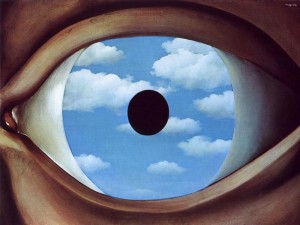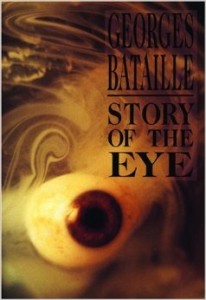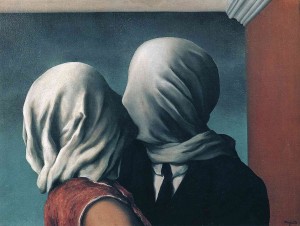Turning a Blind Eye
Kim Grant mentions in her book, Surrealism and the Visual Arts, “Sight is not just one of the senses; it is the sense that structures thought itself” (82). Much of the world that the majority of us experiences is through sight first and then through the other senses. However, vision itself is flawed. No one can see what anyone else sees. As is evident in René Magritte’s work, The False Mirror, we see someone’s eye, it isn’t obvious whose eye it could be, it could be the eye of the viewer or the artist. The ambiguity also lies in who is seeing what.
As much as we can attempt to make the world a shared experience, we are ultimately alone in what and how we see and experience the world. Through vision, we ultimately try to connect with one another, and through blindness, the world becomes even more isolated.
So what are the surrealists trying to accomplish with their constant use of imagery through eyes, both seeing and not seeing, open and closed, seeing and unseeing?
It’s a paradoxical fantasy that the Surrealists have, the one of blindness and vision. For a group so obsessed with sight, and whose basis of experience their art is through the sensation of sight, blindness tends to be a recurring theme. You can only see something for the first time once, and I think that experience and sentiment, although not explicitly expressed by Surrealists is one that they like to play with. Thus, seeing something with an entirely new type of vision can recreate the experience of seeing something for the first time, of getting to re-experience a sensation a feeling, something that you never knew was there in the first place.
They want humanity to not be so dependent on sight, on vision, on seeing in general. However, as artists vision is the means by which they can display their works. Sight is necessary and detrimental. I use the word detrimental, because Surrealists deem vision as a construction that limits the human experience of life: “The constriction of vision eliminated most of those signs that allow individuals to collectively order their experience in terms of problems to be solved in some kind of rational sequence” (Jay 16). A statement by Eric J. Leed which means that we are informed about the world around us by what we see, however, we tend to forget that how we see the world can differ greatly.
In order to explore this theme of vision and blindness and the dichotomy of the two, we need to look at the surrealists’ works to understand their very overt obsession. Two main topics: Vision and Blindness.
Vision
Our lives are almost completely dictated on what we see, and as Grant mentions in Surrealism and the Visual Arts, “Vision alters what we think we know.” We can never know if what we’re seeing is the truth, or merely the manifestation of everything we’ve learned and know and a projection of what think the world is to be.
Magritte, The False Mirror, 1928
Magritte, the Belgian painter, is a standard when talking about surrealism. While he may not been born French, his influence within the Surrealist community as well as his impact and influence on artists. His artwork is considered one of the archetypes of Surrealism, and his works have spread far and wide, there are few people who have not seen The Treachery of Images, 1929.
Though this is not about the pipe and the way it makes one think about the image and how it’s portrayed and whether or not it is actually a pipe.
As mentioned above, the levels of the ambiguity in this piece are astounding, from gender, to whose gaze matters, and playing with subjectivity and objectivity.
The False mirror gives a pictorial representation of the flaw of vision, not failing vision, but vision, as perfect as it can be, the clarity of the clouds showing that, but the obscurity of vision. The obscurity that comes from our eyes playing tricks on us, or seeing things that are not really there.
Vision, our primary sense, is astounding on many levels, but the flaw of vision is vision itself, because even with incredible clarity, we do not know if what we are seeing is true or real.
André Breton, Page-Object, 1934
 André Breton, or “the pope of surrealism,” (Ward) is one of the founders of surrealism and the writer of multiple manifestos of surrealism, and creator of automatic writing amongst other things that are relevant to surrealism and our understanding of the Surrealist movement.
André Breton, or “the pope of surrealism,” (Ward) is one of the founders of surrealism and the writer of multiple manifestos of surrealism, and creator of automatic writing amongst other things that are relevant to surrealism and our understanding of the Surrealist movement.
The Page-Object seems to be a combination of random objects together, and in all honesty could beg the stereotypical response of “Is this art?” However looking at the piece as a whole, one can distinguish what truly makes the object a work of art.
It is a wooden jewelry box with three compartments, to which the open lid exposes. Each compartment contains one thing, two with red marbles with a black center and a fishing fly in the middle. However, the image that one gets while at the Page-Object, is the feeling of two red eyes looking up from the box. The round and shiny objects similar to human eyes. The lid also acts as a means of making the “eyes” unblinking, while at the same time causing a sort of surprise aspect, wherein that if the object were able to be interacted with, one could essentially “open” and “close” the eyes as they so pleased.
Page-Object has eyes wide open, eyes that can see everything, but the sights the eyes can see, no one can ever fathom, much like human vision from person to person.
Blindness
In order to take vision into account, we must also talk about the contrary, or blindness. For that I will start off by mentioning the sun. That which ultimately enables us to see, that which lights the way, is also dangerous for vision. Staring at it too long will eventually cause blindness among a litany of other negative effects. However, in a sense, blindness is a new sort of vision. Which sounds contrived, but for the Surrealists, it was what they were trying to accomplish. A naïve vision, different from what they were seeing and experiencing after the First World War, jamais vu, never seen. There aren’t many ways to see or experience the unseen, but being blind, or becoming blind as it may be, is what the Surrealists have tried time and time again throughout their works.
Georges Bataille–L’histoire de l’oeil
“Perhaps no figure during the subsequent decades expressed both the trauma and the ecstasy of that liberation as powerfully as did Georges Bataille”
 There are many situations in life where placed in any given situation, something we would think is morally reprehensible or inappropriate or anything along those lines, we would think we’d act a certain type of way. However, nothing is guaranteed and we can either act as we thought we would, or upon seeing an action take place, act like nothing ever happened.
There are many situations in life where placed in any given situation, something we would think is morally reprehensible or inappropriate or anything along those lines, we would think we’d act a certain type of way. However, nothing is guaranteed and we can either act as we thought we would, or upon seeing an action take place, act like nothing ever happened.
Which is precisely what happens with Simone’s mother in Georges Bataille’s Histoire de l’oeil. After witnessing multiple sexual acts between her daughter and the narrator of the tale, Simone’s mother continues on like nothing ever happened, like she hadn’t just witnessed unimaginable sex acts between her daughter and a teen-aged boy.
The scenes in which this occur, it is obvious that Simone’s mother is turning a blind eye to the situation at hand, because it is easier to pretend that she never saw the relations between the two than confront the issue.
The Story of the Eye is told biographically, and the reader is placed into a world filled with sex and depravity and mental illness and death. Although the title suggests that it would focus more on the eye, such is not necessarily the case. Bataille tries to convince the reader that blindness is something one can control, especially with the case of Simone’s mother. There are other instances of ridding the eye of the body, however, but are better spoken of in Violation of the Eye
René Magritte, The Lovers, 1928
Another of Magritte’s widely recognized and appropriated, The Lovers, 1928, explores the realm of the blind, the unseen.
The image portrays two people one male and one female kissing, however the conceit is not that, their faces are covered with cloth completely. We cannot see their faces, and they cannot see each other. It is another form of blindness, though we don’t know whether they are purposefully covering their eyes, or the contrary. Within the painting there is a lot that we cannot conceive, aside from the lack of vision, the impossibility of seeing, blindness.
One way of viewing this painting is through the stereotypical lens that love is blind, however, the fact that as the viewer we don’t know whether the people covered themselves or were forcibly covered or even had a choice in the matter for sharing a kiss. This seemingly romantic portrait can be turned on its head when thought of from a different perspective, the Surrealist perspective.
A cursory glance at the painting would suggest romance and love and light, but a more in depth look at the picture leads to darker meaning, something that not many people are necessarily willing to do, because the sight of the two can leave a pleasant feeling, as opposed to being in the dark, the horror that could lie beneath the cloths.
Our blindness, or even unwillingness to see, to look into the depths of the paintings is just what the Surrealists would want to subvert.
What we can learn from the Surrealists is that when you see something, you can’t unsee it, but you’ll also never be able to see it in the same again and blindness gives us the opportunity, by not being able to see, to see the world in a different manner.
We tend to forget that having vision, we are privileged, as Jay mentions in his article, by having vision. Just being able to see the world around us, no matter how different it can be from person to person, it is a privilege. Which is why we must understand and consider that “The importance of vision is not merely indicated by the image itself but by the account of its appearance.” (Grant 81). Kim Grant sums up the issue with vision concisely, that it dictates our lives.
The Surrealists were plagued with this issue, especially seeing as our lives are dictated by the flawed sense, the only way to make it perfect, maybe is to get rid of it completely. Our vision of ourselves and our vision in general. Whether they were concerned with blindness and actually working towards it and achieving it are two completely different things, but by exploring the other side, the blind side, the Surrealists wanted to experience the world for what it was and not how we think it was.




